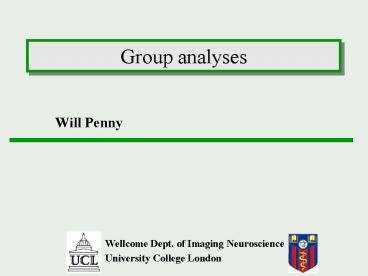Group analyses PowerPoint PPT Presentation
Title: Group analyses
1
Group analyses
Will Penny
- Wellcome Dept. of Imaging Neuroscience
- University College London
2
Data
fMRI, single subject
EEG/MEG, single subject
Time
fMRI, multi-subject
ERP/ERF, multi-subject
Hierarchical model for all imaging data!
3
Reminder voxel by voxel
model specification
parameter estimation
Time
hypothesis
statistic
Time
Intensity
single voxel time series
SPM
4
General Linear Model
Error Covariance
- Model is specified by
- Design matrix X
- Assumptions about e
N number of scans p number of regressors
5
Estimation
1. ReML-algorithm
2. Weighted Least Squares
Friston et al. 2002, Neuroimage
6
Hierarchical model
Multiple variance components at each level
Hierarchical model
At each level, distribution of parameters is
given by level above.
What we dont know distribution of parameters
and variance parameters.
7
Example Two level model
Second level
First level
8
Estimation
Hierarchical model
Single-level model
9
Group analysis in practice
Many 2-level models are just too big to compute.
And even if, it takes a long time!
Is there a fast approximation?
10
Summary Statistics approach
Second level
First level
Data Design Matrix Contrast Images
SPM(t)
One-sample t-test _at_ 2nd level
11
Validity of approach
The summary stats approach is exact if for each
session/subject
Within-session covariance the same
First-level design the same
All other cases Summary stats approach seems to
be robust against typical violations.
12
Auditory Data
Summary statistics
Hierarchical Model
Friston et al. (2004) Mixed effects and fMRI
studies, Neuroimage
13
Multiple contrasts per subject
Stimuli
Auditory Presentation (SOA 4 secs) of words
Motion Sound Visual Action
jump click pink turn
Subjects
(i) 12 control subjects
fMRI, 250 scans per subject, block design
Scanning
What regions are affected by the semantic content
of the words?
Question
U. Noppeney et al.
14
ANOVA
1st level
3.Visual
4.Action
1.Motion
2.Sound
?
?
?
2nd level
15
ANOVA
1st level
Visual
Action
Motion
Sound
?
?
?
2nd level
16
Summary
Linear hierarchical models are general enough
for typical multi-subject imaging data (PET,
fMRI, EEG/MEG).
Summary statistics are robust approximation for
group analysis.
Also accomodates multiple contrasts per subject.
PowerShow.com is a leading presentation sharing website. It has millions of presentations already uploaded and available with 1,000s more being uploaded by its users every day. Whatever your area of interest, here you’ll be able to find and view presentations you’ll love and possibly download. And, best of all, it is completely free and easy to use.
You might even have a presentation you’d like to share with others. If so, just upload it to PowerShow.com. We’ll convert it to an HTML5 slideshow that includes all the media types you’ve already added: audio, video, music, pictures, animations and transition effects. Then you can share it with your target audience as well as PowerShow.com’s millions of monthly visitors. And, again, it’s all free.
About the Developers
PowerShow.com is brought to you by CrystalGraphics, the award-winning developer and market-leading publisher of rich-media enhancement products for presentations. Our product offerings include millions of PowerPoint templates, diagrams, animated 3D characters and more.

